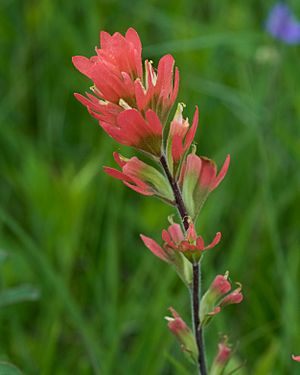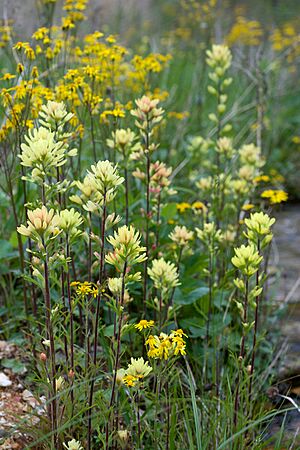Scarlet Indian paintbrush facts for kids
Quick facts for kids Scarlet Indian paintbrush |
|
|---|---|
 |
|
| Castilleja coccinea | |
| Scientific classification | |
| Genus: |
Castilleja
|
| Species: |
coccinea
|
The Scarlet Indian Paintbrush (also called Castilleja coccinea) is a beautiful flowering plant. It belongs to the Orobanchaceae plant family. You can find this plant growing in wet meadows, prairies, and open fields. It lives in many parts of eastern North America, from Maine down to Florida and west to Minnesota and Louisiana.
What Does It Look Like?
This plant stands upright and has tiny hairs. It can grow from about 4 inches (10 cm) to 2.3 feet (70 cm) tall. The main stem usually grows straight up from a group of leaves at its base.
The leaves at the bottom are long and mostly smooth. The leaves higher up on the stem are arranged in a different way. They have deep, uneven cuts or lobes. The plant's common names, like "scarlet Indian paintbrush," come from its bright red parts. These red parts are actually the calyx, which is a cup-like structure. The real flower, called the corolla, is greenish-yellow and hidden inside the red calyx.
You can tell Castilleja coccinea apart from other similar plants. It has a small, thin, yellowish or orange lip on its corolla, which is about 2 to 3.5 millimeters long. Also, the colorful parts (bracts) near the flowers have deep lobes. The group of leaves at the base of the plant is usually easy to see.
How Does It Reproduce?
Castilleja coccinea plants can be either bright scarlet red or yellow. This is called "color polymorphism." The color of the plant can affect how well it reproduces. This often depends on how many pollinators, like bees, are around.
When there are many pollinators, the scarlet red Castilleja coccinea plants tend to produce more seeds and fruits. This means they have more success in making new plants. However, if there are not many pollinators, the yellow Castilleja coccinea plants might have better luck reproducing.
How It Lives and Grows
Even though the Scarlet Indian Paintbrush can grow on its own, it often gets help from other plants. Its roots can attach to the roots of nearby plants. This allows it to take nutrients from them. Studies show that when it does this, the plant can grow up to 40 times bigger! This is a special way it finds food to grow strong.
The main pollinator for this plant is the ruby-throated hummingbird. These tiny birds help the plant reproduce by carrying pollen over long distances. This is important because groups of Castilleja coccinea plants are often small and spread out. The hummingbirds help connect these groups, allowing the plants to share pollen and make new seeds.


